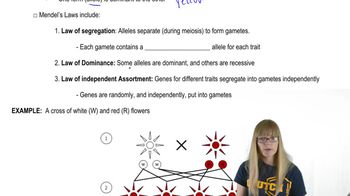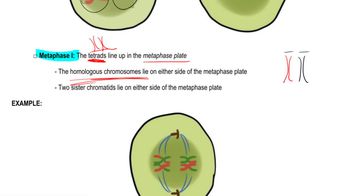Our closest primate relative, the chimpanzee, has a diploid number of 2n =48. For each of the following stages of M phase, identify the number of chromosomes present in each cell.
meiotic metaphase I
Table of contents
- 1. Introduction to Genetics51m
- 2. Mendel's Laws of Inheritance3h 37m
- 3. Extensions to Mendelian Inheritance2h 41m
- 4. Genetic Mapping and Linkage2h 28m
- 5. Genetics of Bacteria and Viruses1h 21m
- 6. Chromosomal Variation1h 48m
- 7. DNA and Chromosome Structure56m
- 8. DNA Replication1h 10m
- 9. Mitosis and Meiosis1h 34m
- 10. Transcription1h 0m
- 11. Translation58m
- 12. Gene Regulation in Prokaryotes1h 19m
- 13. Gene Regulation in Eukaryotes44m
- 14. Genetic Control of Development44m
- 15. Genomes and Genomics1h 50m
- 16. Transposable Elements47m
- 17. Mutation, Repair, and Recombination1h 6m
- 18. Molecular Genetic Tools19m
- 19. Cancer Genetics29m
- 20. Quantitative Genetics1h 26m
- 21. Population Genetics50m
- 22. Evolutionary Genetics29m
9. Mitosis and Meiosis
Meiosis
Problem 7
Textbook Question
Explain how the behavior of homologous chromosomes in meiosis parallels Mendel's law of segregation for autosomal alleles D and d. During which stage of M phase do these two alleles segregate from one another?
 Verified step by step guidance
Verified step by step guidance1
Understand Mendel's law of segregation: This law states that during the formation of gametes, the two alleles for a given gene separate so that each gamete receives only one allele. This is a fundamental principle of inheritance.
Recognize the role of homologous chromosomes in meiosis: Homologous chromosomes are pairs of chromosomes (one from each parent) that carry the same genes but may have different alleles (e.g., D and d). These chromosomes segregate during meiosis, ensuring that each gamete receives one chromosome from each pair.
Identify the stage of meiosis where segregation occurs: During meiosis I, specifically in anaphase I, homologous chromosomes (and their respective alleles, such as D and d) are pulled to opposite poles of the cell. This is the physical basis for Mendel's law of segregation.
Explain the parallel: The separation of homologous chromosomes during anaphase I mirrors Mendel's observation that alleles segregate into different gametes. Each gamete ends up with one allele (either D or d) because the homologous chromosomes carrying these alleles are separated.
Conclude with the importance of meiosis: This process ensures genetic diversity and the proper distribution of alleles to gametes, which is essential for inheritance patterns observed by Mendel.
 Verified video answer for a similar problem:
Verified video answer for a similar problem:This video solution was recommended by our tutors as helpful for the problem above
Video duration:
3mPlay a video:
Was this helpful?
Key Concepts
Here are the essential concepts you must grasp in order to answer the question correctly.
Homologous Chromosomes
Homologous chromosomes are pairs of chromosomes in a diploid organism, one inherited from each parent. They carry the same genes at the same loci but may have different alleles. During meiosis, these chromosomes undergo pairing and recombination, which is crucial for genetic diversity. Understanding their behavior is essential for grasping how alleles segregate during gamete formation.
Recommended video:
Guided course

Chromosome Structure
Mendel's Law of Segregation
Mendel's Law of Segregation states that during the formation of gametes, the two alleles for a trait separate from each other so that each gamete carries only one allele for each gene. This principle explains how offspring inherit one allele from each parent. The law is illustrated during meiosis when homologous chromosomes are separated, ensuring that each gamete receives only one allele from each gene pair.
Recommended video:
Guided course

Mendel's Laws
Meiosis Stages
Meiosis consists of two rounds of cell division: meiosis I and meiosis II. The segregation of alleles occurs during anaphase I of meiosis I, when homologous chromosomes are pulled apart to opposite poles of the cell. This separation ensures that each gamete receives one allele from each pair of homologous chromosomes, aligning with Mendel's law of segregation and contributing to genetic variation in offspring.
Recommended video:
Guided course

Meiosis Steps
Related Videos
Related Practice
Textbook Question
457
views


